Making London Porcelain—A Multidisciplinary Project Connecting Local Communities with the Technological and Innovation Histories of London’s Early Porcelain Manufacturers
Abstract
:1. Introduction
‘Should Be Part of the History Curriculum’
2. Materials and Methods: ‘Without Science Art Cannot Be Successful’
3. Results
3.1. XRF Analysis
3.1.1. Chelsea, Head of a Laughing Child Sculptures
3.1.2. Bow Porcelain
3.2. Raman Analysis
4. Discussion
Public Engagement: ‘Please Make the Bow Porcelain Factory 2.0′
5. Conclusions
Supplementary Materials
Author Contributions
Funding
Data Availability Statement
Acknowledgments
Conflicts of Interest
Appendix A. Making Bow and Chelsea Recipes
- Bone ash—calcium phosphate derived from calcined animal bones;
- Potash feldspar—mineral derived from decomposed granite which is used as a flux;
- Ball clay—very fine particle sized clay, named after the 30 lbs ‘balls’ it was shaped into in Dorset for transportation, which is a ‘secondary clay’ formed into deposits from eroded granite rocks;
- Alkaline frit—ground glass;
- Kaolin—clay high in alumina, named after kao ling—high mountains—it is a ‘primary clay’ washed from the rock face with water;
- Quartz—a natural crystalline silicon oxide;
- Flint—a natural silicon oxide, but not as pure as quartz;
- Flux—an oxide that lowers the melting point of a glaze and helps a clay body vitrify.
- 40 g kaolin;
- 10 g potash feldspar;
- 10 g quartz.
- 15 g ball clay;
- 15 g quartz;
- 28 g bone ash;
- 2 g high alkaline frit;
- Optional: 0.01 g cobalt oxide.
- 30 g ball clay;
- 7.5 g quartz;
- 6 g flint;
- 6 g high alkaline frit;
- 3 g potash feldspar.
| 1 | This work and the scientific analysis would not have been possible without the excellent work conducted by Dr Valentina Risdonne and Dr Lucia Noor Melita in the V&A Science Lab. |
| 2 | We are especially grateful to Matthew Winterbottom, Curator of Sculpture and Decorative Arts at The Ashmolean Museum for helping to facilitate this loan. |
| 3 | Two key events were held as part of this discussion, including a Knowledge Sharing Workshop and Discussion Group at the V&A in May 2022, and a Public Lunchtime Lecture at the V&A in November 2022. |
| 4 | London Borough of Newham, see also ref. 12 by Gabszewicz. |
| 5 | As surface topography was not always completely flat, quantified results are used as an indication or approximation of concentration. |
| 6 | Estimated sulfur content based on comparison of the SKα peak areas with those in glass standards Corning A and Corning B (which have similar levels of lead to the porcelain) due to issues with Artax software deconvoluting SKα lines and PbMα lines. |
References
- Edwards, H.G. 18th and 19th Century Porcelain Analysis. A Forensic Provenancing Assessment; Springer: Cham, Germany, 2020. [Google Scholar]
- Edwards, H.G. Porcelain Analysis and Its Role in the Forensic Attribution of Ceramic Specimens; Springer: Cham, Switzerland, 2022. [Google Scholar]
- Making London Procelain. Available online: https://www.vam.ac.uk/research/projects/making-london-porcelain (accessed on 15 December 2022).
- Vice-Chancellor of University of Cambridge, Professor Sir Leszek Borysiewicz. Available online: https://www.cam.ac.uk/public-engagement/what-is-public-engagement (accessed on 15 December 2022).
- Available online: https://collections.vam.ac.uk/item/O1500933/head-roubiliac-louis-fran%C3%A7ois/head-roubiliac-louis-fran%C3%A7ois/ (accessed on 15 December 2022).
- Available online: https://collections.ashmolean.org/collection/browse-9148/per_page/25/offset/7850/sort_by/random/object/66608 (accessed on 15 December 2022).
- Accompt-Book of the Bow Porcelain Factory; The British Library: London UK, 1755.
- Defoe, D.; Rogers, P. A Tour through the Whole Island of Great Britain, 6th ed.; Samuel, R., Ed.; Penguin UK: London, UK, 1761; Volume 1, p. 2. [Google Scholar]
- Ramsay, W.R.H.; Davenport, F.A.; Ramsay, E.G. The 1744 Ceramic Patent of Heylyn and Frye: ‘Unworkable Unaker Formula’ or Landmark Document in the History of English Ceramics? Proc. R. Soc. Vic. 2006, 118, 11. [Google Scholar]
- Ramsay, W.R.H.; Gabszewicz, A.; Ramsay, E.G. ‘Unaker’ or Cherokee Clay and Its Relationship to the ‘Bow’ Porcelain Manufactory. Engl. Ceram. Circ. Trans. 2001, 17 Pt 3, 473–499. [Google Scholar]
- Dibble, R.R.; Zordan, J.M. Cherokee Unaker, British Ceramics, and Productions of Whiteness in Eighteenth-Century Atlantic Worlds. Available online: https://www.britishartstudies.ac.uk/index/article-index/british-ceramics-and-productions-of-whiteness/article-category/article (accessed on 15 December 2022).
- Gabszewicz, A. Made at New Canton, Bow Porcelain from the Collection of the London Borough of Newham; The English Ceramic Circle: London, UK, 2000; p. 15. [Google Scholar]
- The Bowcock Papers, MSS.45905; The British Library: London, UK, 1993.
- Adams, E. Chelsea Porcelain; British Museum Press: London, UK, 2001. [Google Scholar]
- John, V.G. Mallet, A painting of Nicholas Sprimont, his family and his Chelsea Vases. Available online: https://www.persee.fr/doc/camar_0776-1317_1993_num_24_1_1111 (accessed on 15 December 2022).
- Available online: https://www.britishmuseum.org/collection/object/H_1938-0314-96-CR (accessed on 15 December 2022).
- Gardner, H.B. The Connoisseur; 1938; pp. 59–60. [Google Scholar]
- Penny, N. Catalogue of European Sculpture in the Ashmolean Museum, 1540 to the Present Day; Clarendon Press and the Ashmolean Museum: Oxford, UK, 1992; p. 17. [Google Scholar]
- Laughing Child • V&A Blog. Available online: https://www.vam.ac.uk/blog/museum-life/a-laughing-child (accessed on 15 December 2022).
- Bezur, A.; Casadio, F. The analysis of porcelain using handheld and portable X-ray fluorescence spectrometers. In Handheld XRF for Art and Archaeology; Shugar, A.N., Mass, J.L., Eds.; Leuven University Press: Leuven, Belgium, 2013; pp. 249–312. [Google Scholar]
- Dunster, J. Developing a Methodology for the Non-Destructive Analysis of British Soft-Paste Porcelain. Ph.D. Thesis, Cranfield University, Bedford, UK, 2016; p. 110. [Google Scholar]
- Tite, M.S.; Bimson, M. A technological study of English porcelains. Archaeometry 1991, 33, 3–27. [Google Scholar] [CrossRef]
- Mallet, J.V.G. Hogarth’s pug in porcelain. In Victoria and Albert Museum Bulletin Preprints 16; Victoria and Albert Museum: London, UK, 1971. [Google Scholar]
- Domoney, K.; Shortland, A.J.; Kuhn, S. Characterisation of 18th-century Meissen porcelain using SEM-EDS. Archaeometry 2012, 54, 454–474. [Google Scholar] [CrossRef]
- Bezur, A.; Casadio, F.; Domoney, K.; Eremin, K.; Lee, L.; Mass, J.L.; Shortland, A.; Zumbulyadis, N. X-ray fluorescence applied to overglaze enamel decoration on eighteenth- and nineteenth-century porcelain from central Europe. Stud. Conserv. 2012, 57 (Suppl. 1), 61–72. [Google Scholar]
- Dunster, J.; Domoney, K. Scientific analysis of coloured grounds and enamel decoration on Worcester porcelain in the Ashmolean Museum. In The Marshall Collection of Worcester Porcelain in the Ashmolean Museum; Sword, R., Ed.; University of Oxford: Oxford, UK, 2017. [Google Scholar]
- Hunt, L.B. The true story of Purple of Cassius. Gold Bull. 1976, 9, 134–139. [Google Scholar] [CrossRef] [Green Version]
- Ramsay, W.; Ramsay, E. A classification of Bow porcelain from first patent to closure: C.1743–1774. Proc. R. Soc. Vic. 2007, 119, 1. [Google Scholar]
- Ramsay, W.; Sutton, K.; Ramsay, E. Bow porcelain: Glaze compositions associated with the phosphatic wares ~1742–1774. Proc. R. Soc. Vic. 2011, 123, 161–171. [Google Scholar]
- Edwards, H.G.; Jay, W.H.; Ramsay, W.R.H. High-fired early English porcelains of the ‘A’-marked group, east London (c. 1744): A Raman spectroscopy and electron microscopy compositional study. J. Raman Spectrosc. 2022, 53, 785–809. [Google Scholar] [CrossRef]
- Edwards, H.G.; Colomban, P.; Bowden, B. Raman spectroscopic analysis of an English soft-paste porcelain plaque-mounted table. J. Raman Spectrosc. 2004, 35, 656–661. [Google Scholar] [CrossRef]
- Jay, W.H.; Orwa, J.O. Raman spectroscopy applied to early (ca. 1746–1754) English steatitic porcelains: A tentative study of compositions. J. Raman Spectrosc. 2012, 43, 307–316. [Google Scholar] [CrossRef]
- Ramsay, E.G.; Ramsay, W.R.H. Bow: Britain’s pioneering porcelain manufactory of the 18th century. In The International Ceramics Fair and Seminar; 2007; Available online: https://www.bowporcelain.net/Bow%20Britains%20Pioneering%20Porcelain%20Manufactory.doc (accessed on 15 December 2022).
- Adamson, G. The Case for Material Intelligence. Aeon Magazine November 2018. Available online: https://www.glennadamson.com/work/2018/11/18/materialintelligence (accessed on 15 December 2022).
- Walvin, J. A Sugar Bowl. In Slavery in Small Things; Wiley: Oxford, UK, 2017; pp. 11–37. [Google Scholar]
- Available online: https://www.themanufacturer.com/articles/new-analysis-reveals-design-and-technology-student-numbers-have-fallen/ (accessed on 15 December 2022).
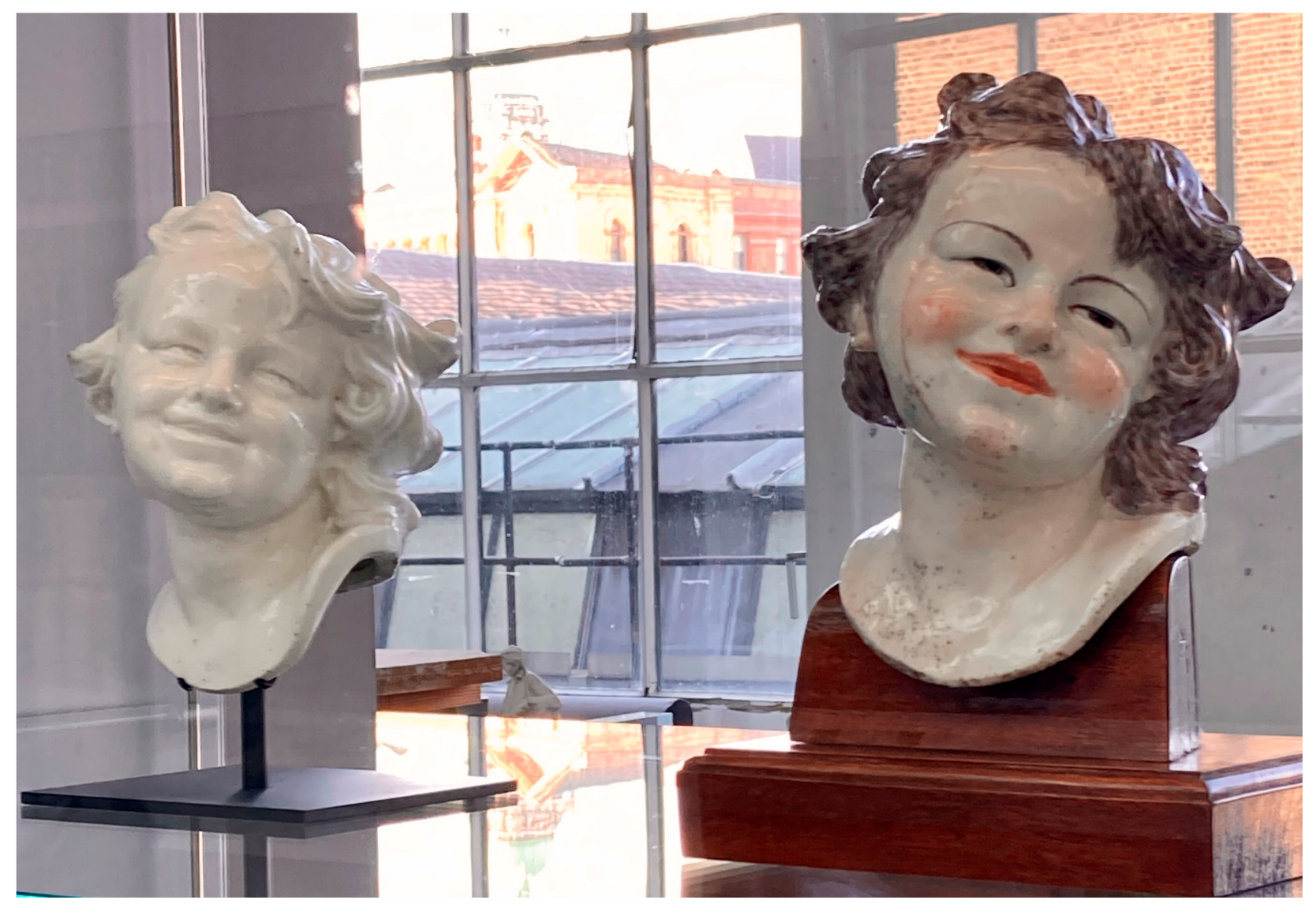
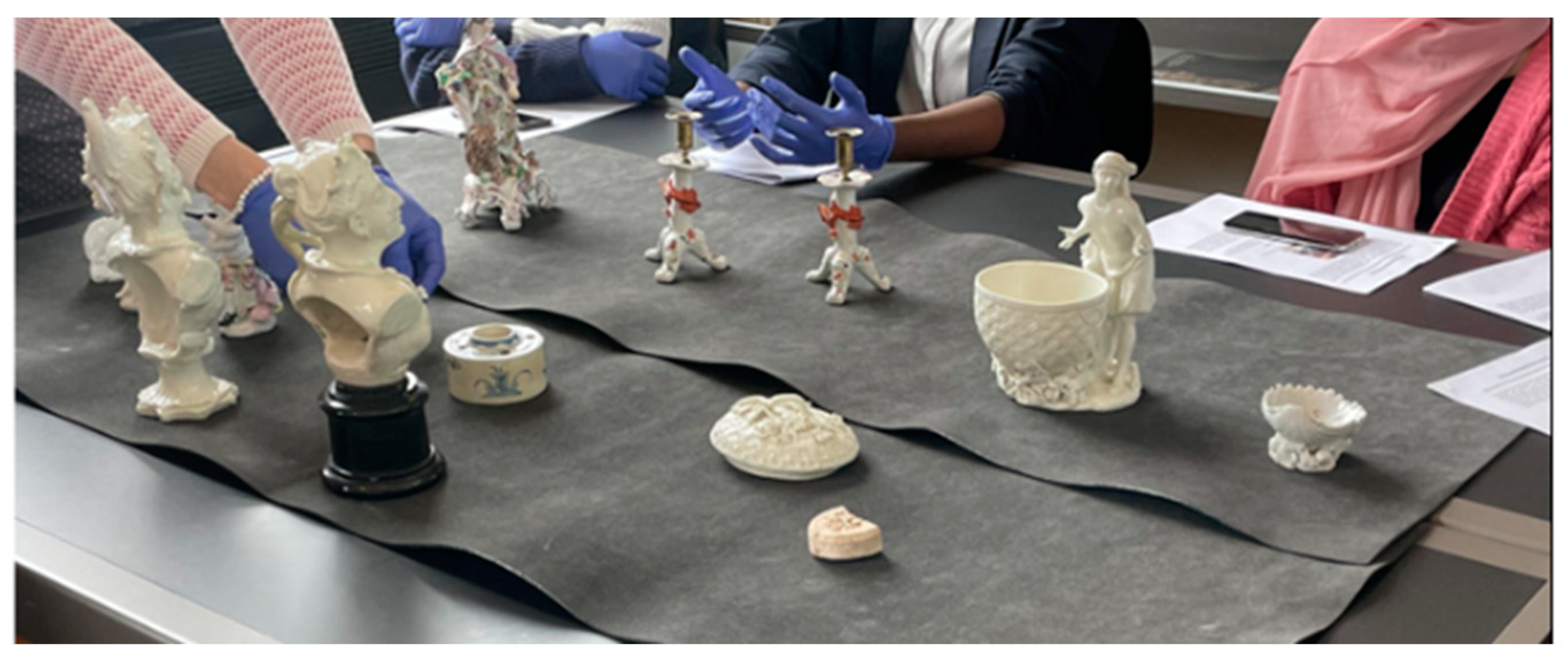



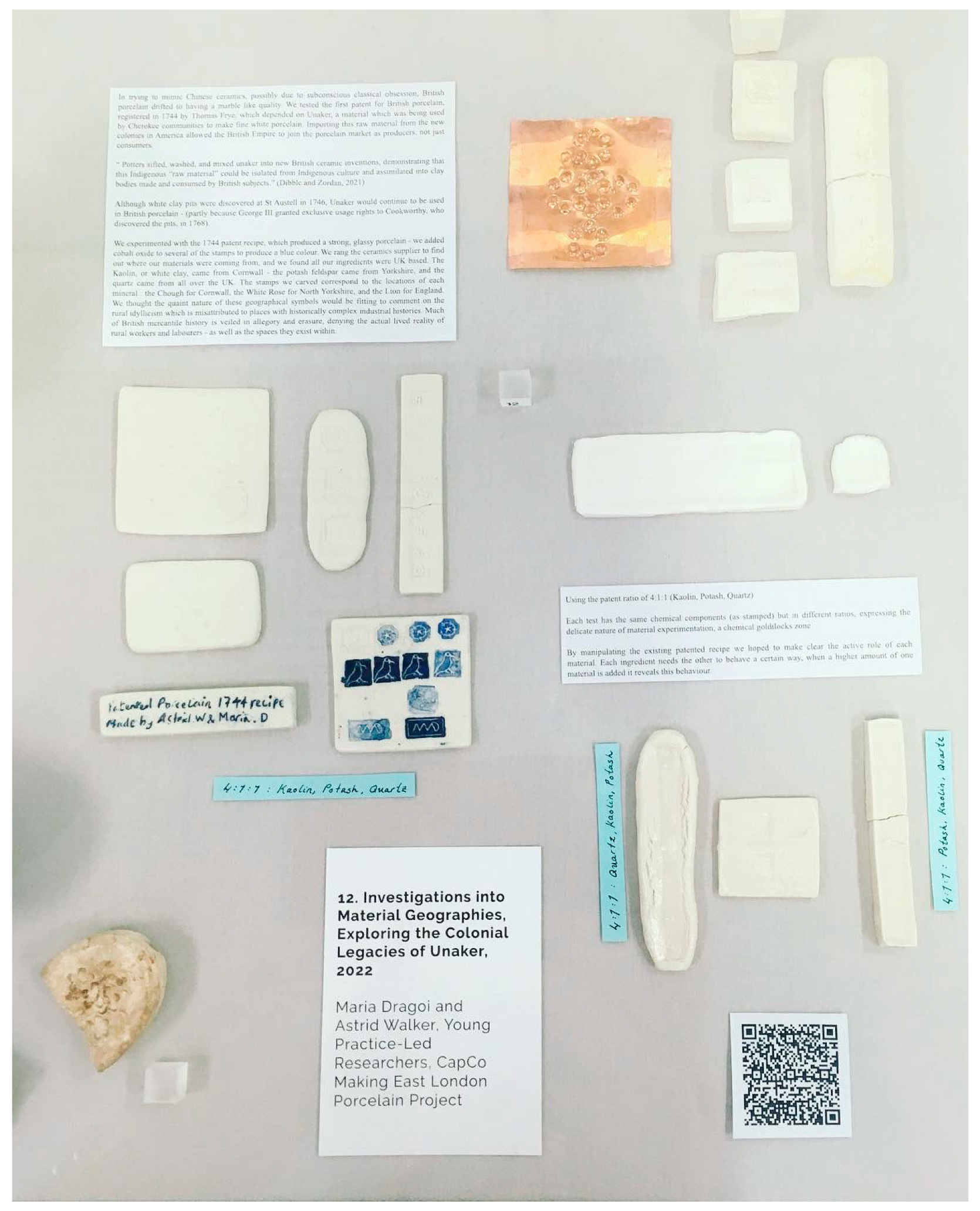

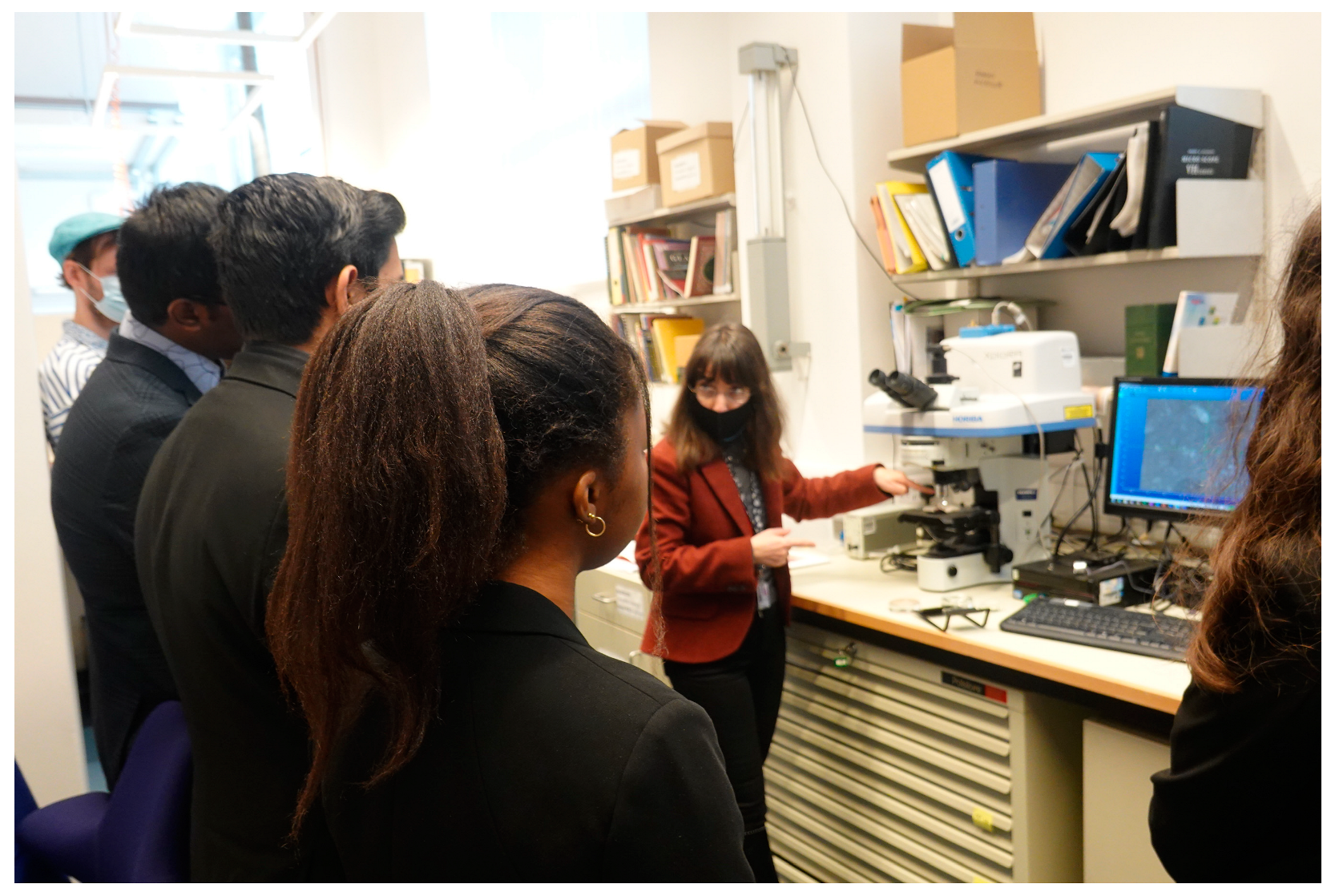


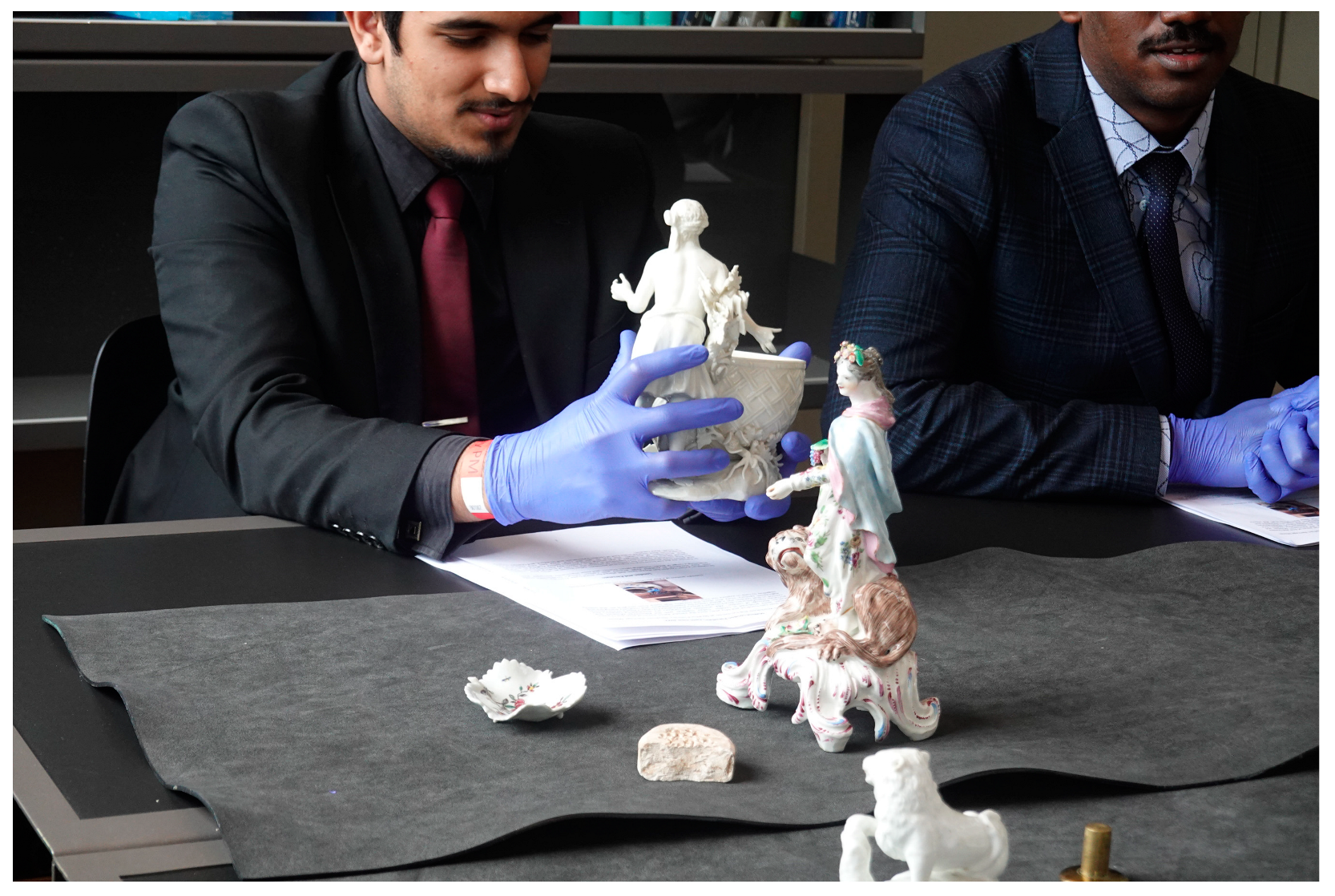
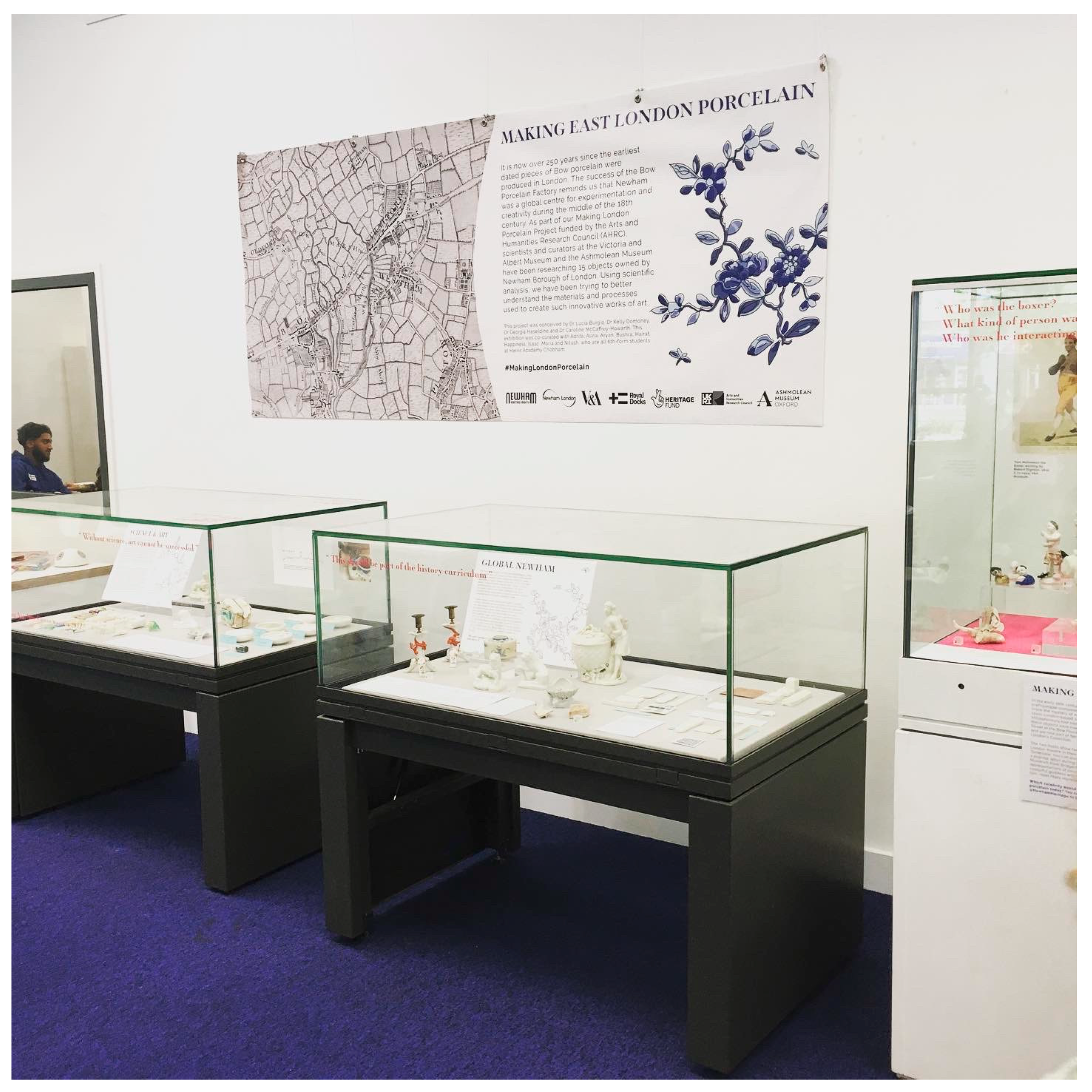
| Object No. | Description | Factory | Date | Location | Components Analysed | Technique |
|---|---|---|---|---|---|---|
| WA1965_8 | Head of a Laughing Child | Chelsea | c. 1746-1752 | Ashmolean Museum | Paste, glaze, enamels | µXRF |
| C.37-2019 | Head of a Laughing Child | Chelsea | c. 1746-1749 | V&A Museum | Paste, glaze | µXRF |
| 2864-1901 | Inkwell | Bow | 1751 | V&A Museum | Glaze | Raman |
| PROV.466-2022 | Shell salt | Bow | c. 1747-1749 | Newham Archive | Paste, glaze | µXRF, Raman |
| PROV.467-2022 | Pickle dish | Bow | c. 1747-1749 | Newham Archive | Paste, glaze | µXRF, Raman |
| PROV.469:1 | Tamerlane bust, Timur | Bow | c. 1750 | Newham Archive | Paste, glaze | µXRF |
| PROV.469:2 | Tamerlane bust, Aspasia | Bow | c. 1750 | Newham Archive | Glaze | µXRF |
| PROV.475:1-2022 | Waster, flower shard | Bow | c. 1750 | Newham Archive | Paste | µXRF, Raman |
| PEM.16705 | Lion figure | Bow | c. 1750 | Newham Archive | Paste, glaze | µXRF |
| PEM.16706 | Lion figure | Bow | c. 1750 | Newham Archive | Paste, glaze | µXRF |
| PEM.LDLHAA0001_4017 | Lion figure | Bow | c. 1750 | Newham Archive | Paste, glaze | µXRF |
| PROV.463-2022 | Ink pot | Bow | c. 1750 | Newham Archive | Glaze | µXRF, Raman |
| PROV.468:1-2022 | Ink pot lid | Bow | c. 1750 | Newham Archive | Glaze | µXRF |
| PROV.468:2-2022 | Bowl | Bow | c. 1750 | Newham Archive | Glaze | µXRF |
| Object No. | Description | Date | Factory | SiO2 | K2O | CaO | Al2O3 | FeO | P2O5 | TiO2 | MnO | CuO | CoO | NiO | ZnO | SrO | ZrO2 | SnO2 | PbO | SO2 |
|---|---|---|---|---|---|---|---|---|---|---|---|---|---|---|---|---|---|---|---|---|
| Porcelain bodies | ||||||||||||||||||||
| WA1965_8 | Laughing Child | 1746-52 | Chelsea | 61.1 | 4.6 | 10.0 | 0.6 | 0.3 | - | 0.1 | 0.1 | 0.6 | - | - | 0.2 | - | 0.01 | - | 10.7 | - |
| C37-2019 | Laughing Child | 1746-50 | Chelsea | 52.1 | 3.3 | 6.7 | 0.5 | 0.3 | - | 0.1 | 0.1 | 0.6 | - | - | 0.03 | - | 0.01 | - | 8.3 | - |
| PROV466-2022 | Shell salt | c. 1747-49 | Bow | 44.6 | 0.7 | 29.2 | 7.1 | 0.4 | 22.8 | 0.2 | 0.1 | 0.6 | 0.04 | 0.02 | 0.03 | 0.1 | 0.002 | - | <0.01 | nq |
| PROV467-2022 | Pickle dish | c. 1747-50 | Bow | 48.1 | 1.2 | 33.1 | 6.8 | 0.4 | 24.1 | 0.3 | 0.1 | 0.6 | 0.05 | 0.02 | 0.03 | 0.1 | 0.01 | - | <0.01 | nq |
| PROV469_1 | Tamerlane bust, male | c. 1750 | Bow | 63.6 | 0.9 | 31.6 | 9.3 | 0.5 | 29.1 | 0.3 | 0.1 | 0.6 | 0.03 | 0.01 | 0.03 | 0.1 | 0.007 | - | <0.01 | - |
| PROV.475:1-2022 | Waster | c. 1750 | Bow | 57.8 | 1.9 | 27.4 | 4.7 | 0.4 | 26.1 | 0.2 | 0.1 | 0.6 | - | 0.01 | 0.03 | 0.1 | 0.004 | - | <0.01 | - |
| PEM.16705 | Lion figure | c. 1750 | Bow | 57.6 | 2.0 | 25.1 | 7.3 | 0.4 | 28.2 | 0.2 | 0.1 | 0.1 | - | 0.04 | 0.04 | 0.1 | 0.004 | - | <0.01 | - |
| Porcelain glazes | ||||||||||||||||||||
| WA1965_8 | Laughing Child | 1746-52 | Chelsea | 40.5 | 2.1 | 3.0 | 1.6 | 0.1 | - | 0.004 | 0.1 | 0.6 | - | - | - | - | - | 3.8 | 41.5 | - |
| C37-2019 | Laughing Child | 1746-49 | Chelsea | 45.6 | 2.6 | 4.6 | 1.6 | 0.2 | - | 0.03 | 0.1 | 0.6 | - | - | - | - | - | 2.0 | 40.0 | - |
| PROV466-2022 | Shell salt | c. 1747-49 | Bow | 41.5 | 0.8 | 2.2 | 2.1 | 0.1 | 2.4 | 0.01 | 0.1 | 0.6 | - | - | - | - | - | - | 52.7 | - |
| PROV467-2022 | Pickle dish | c. 1747-50 | Bow | 44.3 | 1.0 | 2.3 | 2.4 | 0.1 | 2.4 | 0.01 | 0.1 | 0.6 | - | - | - | - | - | - | 57.3 | - |
| PROV469_1 | Tamerlane bust, male | c. 1750 | Bow | 42.9 | 1.6 | 1.7 | 1.9 | 0.1 | 0.7 | 0.02 | - | 0.6 | - | - | - | - | - | - | 44.1 | - |
| PROV469_2 | Tamerlane bust, female | c. 1750 | Bow | 48.0 | 1.8 | 2.1 | 2.4 | 0.1 | 1.3 | 0.01 | - | 0.6 | - | - | - | - | - | - | 53.0 | - |
| PEM.16705 | Lion figure | c. 1750 | Bow | 49.7 | 2.1 | 2.2 | 1.9 | 0.1 | - | 0.01 | - | 0.6 | - | - | - | - | - | - | 54.2 | - |
| PEM.16706 | Lion figure | c. 1750 | Bow | 52.1 | 1.7 | 2.6 | 0.9 | 0.1 | 0.03 | 0.02 | - | 0.6 | - | - | - | - | - | - | 58.4 | - |
| PEM.LDLHAA0001/4017 | Lion figure | c. 1750 | Bow | 48.9 | 2.5 | 2.4 | 1.3 | 0.1 | - | 0.01 | - | 0.6 | - | - | - | - | - | - | 52.0 | - |
| PROV.463-2022 | Ink pot | c. 1750 | Bow | 47.2 | 2.1 | 2.0 | 1.1 | 0.1 | 1.01 | 0.02 | - | 0.6 | - | - | - | - | - | - | 52.3 | - |
| PROV.468:1-2022 | Ink pot lid | c. 1750 | Bow | 51.9 | 2.3 | 2.0 | 2.5 | 0.1 | 1.42 | 0.02 | - | 0.6 | - | - | - | - | - | - | 59.8 | - |
| PROV.468:2-2022 | Bowl | c. 1750 | Bow | 48.9 | 2.1 | 2.3 | 1.9 | 0.1 | 1.13 | 0.02 | - | 0.6 | - | - | - | - | - | - | 55.2 | - |
Disclaimer/Publisher’s Note: The statements, opinions and data contained in all publications are solely those of the individual author(s) and contributor(s) and not of MDPI and/or the editor(s). MDPI and/or the editor(s) disclaim responsibility for any injury to people or property resulting from any ideas, methods, instructions or products referred to in the content. |
© 2023 by the authors. Licensee MDPI, Basel, Switzerland. This article is an open access article distributed under the terms and conditions of the Creative Commons Attribution (CC BY) license (https://creativecommons.org/licenses/by/4.0/).
Share and Cite
Burgio, L.; Domoney, K.; Haseldine, G.; McCaffrey-Howarth, C. Making London Porcelain—A Multidisciplinary Project Connecting Local Communities with the Technological and Innovation Histories of London’s Early Porcelain Manufacturers. Heritage 2023, 6, 1958-1976. https://doi.org/10.3390/heritage6020105
Burgio L, Domoney K, Haseldine G, McCaffrey-Howarth C. Making London Porcelain—A Multidisciplinary Project Connecting Local Communities with the Technological and Innovation Histories of London’s Early Porcelain Manufacturers. Heritage. 2023; 6(2):1958-1976. https://doi.org/10.3390/heritage6020105
Chicago/Turabian StyleBurgio, Lucia, Kelly Domoney, Georgia Haseldine, and Caroline McCaffrey-Howarth. 2023. "Making London Porcelain—A Multidisciplinary Project Connecting Local Communities with the Technological and Innovation Histories of London’s Early Porcelain Manufacturers" Heritage 6, no. 2: 1958-1976. https://doi.org/10.3390/heritage6020105
APA StyleBurgio, L., Domoney, K., Haseldine, G., & McCaffrey-Howarth, C. (2023). Making London Porcelain—A Multidisciplinary Project Connecting Local Communities with the Technological and Innovation Histories of London’s Early Porcelain Manufacturers. Heritage, 6(2), 1958-1976. https://doi.org/10.3390/heritage6020105








